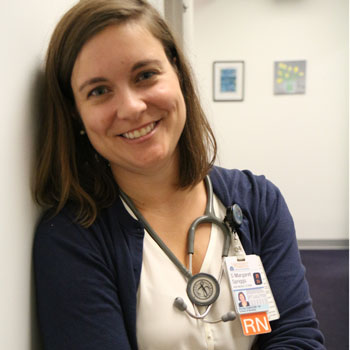Remind & Recall Program Ups Refugees Kids' Vaccination Rates

Vaccination rates among refugee children coming to the U.S. vary wildly, from just over half to about 85 percent, compared to about 90 percent of native-born children. But when primary care offices use a reminder and recall program to reach out to parents of children in need of vaccines, compliance among refugee families improves.
Those are the findings of nurse practitioner Maggie Spriggs (DNP `19), who recently presented findings of capstone project that focused on increasing vaccination rates among refugee children who are receiving care at the Primary Care Center at UVA Family Medicine's clinic.
"This experience has taught me that if there's something you see as a need, it can be done."
Maggie Spriggs, a family nurse practitioner and a DNP student
Peering into their medical records, Spriggs found 120 kids under age four who were missing a vaccine. Working with a clinic volunteer last fall and winter, Spriggs contacted each child's parents to set up an appointment (using translators where necessary) or reached their provider about their vaccine needs if they already had an appointment and did not respond to two phone calls.
Before the intervention, 81.6 percent of children under age 4 being treated at the clinic were up-to-date on their vaccines; after Spriggs' intervention, 91.7 percent had received all the required vaccinations or had an appointment to get them. More than half of parents - 54.5 percent - who received a reminder call made an appointment so their child could receive a needed vaccine. Interestingly, Spriggs had no documented cases of parents vaccine refusal from the refugee parents, who came largely from Middle Eastern, African and Asian countries including Afghanistan, Iraq, the Democratic Republic of Congo, Syria, Russia, Bhutan, and Burma.
Spriggs found that missed well-child visits were the biggest reasons for missing a vaccine, that English-speakers were not necessarily more likely to be vaccinated, and that families from southern and eastern Asia were the least likely to miss vaccines. Spriggs also found a positive association between time spent in the U.S. and improved vaccination rates, surmising that as refugees acclimate to their new country they get better at navigating the healthcare system.
 The process, Spriggs says, has opened her eyes to how to tackle problems systemically, and the needed steps to move from a challenge to its solution.
The process, Spriggs says, has opened her eyes to how to tackle problems systemically, and the needed steps to move from a challenge to its solution.
"This experience has taught me that if there's something you see as a need, it can be done," said Spriggs.
Prior to the current administration, about 75,000 refugees resettled in the U.S. each year, of which 30 and 40 percent are children. And while 85 to more than 90 percent of native-born children (19 to 35 months) are fully vaccinated, refugee children are significantly less likely to be up-to-date: just 75 to 80 percent have had the shots they need.
Intended or not, falling behind on vaccinations is a serious public health issue.
“When people don’t get vaccinated, it puts us all at risk,” explains Spriggs, pointing to the resurgence of whooping cough and measles among non-vaccinated people. “It’s not just about your child, or just yourself any longer.”
With the capstone now behind her, Spriggs hopes the quality improvement project continues in the clinic and that the partnerships she forged - with agencies, from the Charlottesville Health Department, Jefferson Area CHIP, the city and county schools and the International Refugee Committee - will continue.
It’s critical buy-in, says Spriggs.
“An NP colleague said to me, ‘You can come in with Maggie’s great idea, but you may not be successful until you have information and input from the larger group of people who have perspective and can give you a fuller picture,’” said Spriggs. “It’s felt like a team effort from the beginning.”
###
